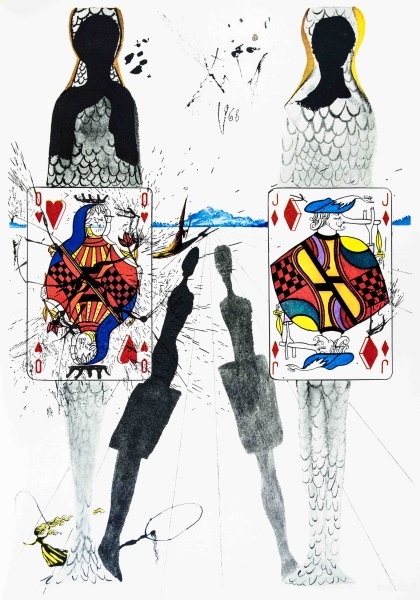Carroll: ‘Alice's Adventures in Wonderland’
In 1969, the work of two artists who died one hundred years apart came together when Maecenas Press– Random House issued Lewis Carroll’s famous story published as Alice’s Adventures in Wonderland with illustrations by surrealist painter Salvador Dalí. The pairing of a nineteenth-century logician’s tale of a little girl who wanders down a rabbit hole and a master of twentieth-century modern art might seem, by turns, shocking and a stroke of genius. That is precisely what makes this rare collaboration so remarkable.
What links Carroll and Dalí is their shared fascination with the fantastic, the dream world, and their respective cultures’ reliance on space and time to order human experience. What better way to turn staid convention topsy turvy than to envision the world through the imagination of a child? And who better than a surrealist to express the world of unconscious desire, counter logic, and alternate realities that Alice encounters on her journey?
Dalí was not the first surrealist to be attracted to Carroll’s oeuvre, nor was he the first to recognize Carroll as a kindred spirit (Schulz 14). In 1936, André Breton observed, “Swift is Surrealist in malice, … Poe is Surrealist in adventure. … Carroll is Surrealist in nonsense” (Stern 133).
Dalí’s revisionings for Alice’s Adventures include a four-color etching of Alice as the frontispiece and twelve heliogravures (a photographic engraving process)—one for each chapter. To be sure, many of the familiar characters Alice meets in Wonderland appear in these illustrations— the White Rabbit, the Caterpillar, the Mock Turtle, and the Queen of Hearts. And so do many of Dalí’s signature touches—a melting watch, butterflies, bifurcated crutches, and objects out of proportion to one another.
Dalí brings Alice’s wonder-dream to life while drawing on many of Carroll’s narrative tropes. Alice meets a March Hare, a Hatter, and a sleepy Dormouse at “A Mad Tea Party” where it is always teatime and Time controls its own measurement. Dalí depicts this absurdity by creating a scene in which a tree has grown through the center of a wilting timepiece piece fixed at six o’clock. In her conversation with a hookah-smoking caterpillar, Alice learns she can adjust her size by eating bits of mushroom— from different sides of the plant. Dalí renders the transformations from Alice’s point of view by painting two caterpillars— one realistic in green, the other gargantuan in electric blue, yellow, and red. The juxtaposition of the two caterpillars allows the viewer to experience the natural and phantasmic worlds co-existing on the same plane.
As the central character, Alice appears in all thirteen images, consistently portrayed as a small, shadowed figure jumping rope. Her outline—always with the rope raised midair—suggests a capital A. In this way, Dalí captures Alice’s experimentation with changing her size while suggesting a child’s perspective of an adult world. Dalí’s illustrations of Carroll’s story remind us of the permeability of boundaries and the riches of imagination.
—Margaret Strain, PhD, Professor, English
Margaret Strain, professor of English, discusses Carroll’s fascination with dreamworlds and the imagery of Alice as rendered by the artist Salvador Dalí. Interview is an online supplement to the University of Dayton exhibit Imprints and Impressions: Milestones in Human Progress—Highlights from the Rose Rare Book Collection, held Sept. 29 through Nov. 9, 2014.
Works Cited
Carroll, Lewis. Alice’s Adventures in Wonderland. Illus. by Salvador Dalí. Maecenas PressRandom House, 1969. Print.
Schulz, Christoph Benjamin. “Down the Rabbit Hole and Into the Museum: Alice—and the— Visual Arts.” Alice in Wonderland through the Visual Arts. Ed. Gavin Delahunty and Christoph Benjamin Schulz. London: Tate Liverpool, 2011. 8-35. Print.
Stern, Jeffrey. “Lewis Carroll the Surrealist.” Lewis Carroll: A Celebration: Essays on the Occasion of the 150th Anniversary of the Birth of Charles Lutwidge Dodgson. Ed. Edward Guiliano. New York: Clarkson N. Potter, 1982. 132-53. Print

